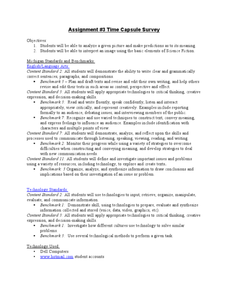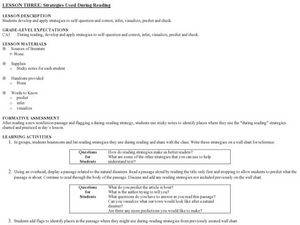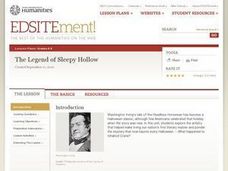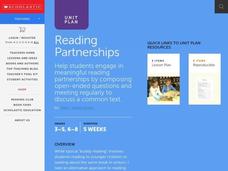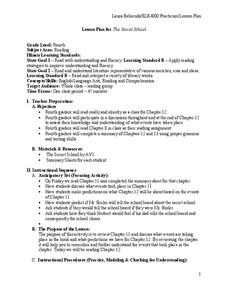Curated OER
Pre Reading Strategies
Students use their journals in order to predict what will happen in a text for a prereading strategy. In this prereading lesson plan, students list the 5 strategies they learn and use them before they read.
Curated OER
Applying Reading Strategies to Aid Comprehension
Students practice their reading skills. In this reading comprehension lesson, students read articles about fast food topics using the wordstorming strategy described to prepare for reading the text.
Curated OER
Reading About the Journey: The Odyssey
Young scholars practice their reading skills. In this reading fluency and comprehension lesson, students read instructor-selected passages from The Odyssey following the provided steps for the reading class activity that requires them to...
Curated OER
Time Capsule Survey
Here's a fun way to incorporate technology into your curriculum. E-mail each of your class members a picture and 10 questions about the photo. Individuals then imagine the story behind the image and e-mail back their responses. Although...
West Corporation
Making Inferences – Use Your Mind to Read!
How can you tell if someone is happy? The lesson works with elementary and middle school scholars to activate their schema and pay attention to details to make inferences in their daily lives, poetry, and other literature. Cleverly...
Super Teacher Worksheets
Literature Circle Packet
Looking to set up literature circles in your class? Use these materials to support pupils when they meet in groups. Pupils take on various roles over the course of reading and meet with their groups to share the work they have done on...
National Council of Teachers of Mathematics
Cash or Gas?
Which option provides the best payout? Pupils predict which lottery prize to take. They devise a method to calculate which prize would likely provide the greatest monetary value.
Curated OER
Strategies Used During Reading
Students try a variety of reading strategies. In this reading strategy lesson, students read a nonfiction passage and put Post -Its to mark the spots where they are using a reading strategy. They focus on inferring, predicting,...
Curated OER
Strategies for pre reading, during reading, & after reading
Fourth graders participate in a lesson using the whole reading of text. They work on skills like prediction and summary. The predictions in particular are analyzed and changed as needed when summarizing.
Curated OER
Guided Reading: Shapes Where We Play
Students discover shapes on a playground. In this guided reading lesson, students discover new vocabulary words related to shapes as they read Shapes Where We Play. In small groups, students use picture clues and one to one matching to...
Curated OER
Guided Reading with Twister's Tricks
Students participate in pre-reading activities before reading the book, Twister's Tricks. They read the book independently, but are guided by directive questions from their teacher. A discussion follows, as well as repeated readings for...
Curated OER
Rosencrantz and Guildenstern Are Dead: Pre-Reading Strategy
Get your class ready to read Rosencrantz and Guildenstern Are Dead by Tom Stoppard with an anticipation guide. This document describes exactly how to create and implement an anticipation guide.
Curated OER
Directed Reading Thinking Activity: Cold Sassy Tree
Lots of questions arise when reading Cold Sassy Tree. As your class encounters the twentieth chapter, encourage a rich discussion with some of the questions provided here. Then, either independently, or for homework, ask your readers to...
Curated OER
A Weekend with Wendell
Students discuss the term prediction. In this language arts lesson, students predict what will happen next by using the turn & talk strategy. Students chart the predictions each one makes.
Curated OER
The Legend of Sleepy Hollow
Fourth graders read The Legend of Sleepy Hollow aloud, make predictions, compare characters, discuss plot and setting, and rewrite the ending to the story.
Curated OER
Trouble with Trolls
Second graders read Trouble with Trolls. In this author/illustrator lesson, 2nd graders read a story and discuss their favorite parts. Students make predictions and connections to the book.
Curated OER
Introducing the Memo
Examine the text structure of a memo with this worksheet. Eighth to twelfth graders decide if the purpose of a memo is to motivate an action or to provide information to the reader. They explore new vocabulary and make predictions prior...
Curated OER
Sink or Float
Second graders explore floating and sinking and make predictions about whether certain objects are likely to sink or float. They read the story Who Sank the Boat? by Pamela Allen. Pupils loacate rhyming words and discuss the events of...
Curated OER
Reading Partners
Students participate in several activities using a reading partner. They plan and organize reading meetings with their partner, and then review story elements by retelling the stories orally. The partners question each other and make...
Curated OER
Rain
First graders practice oral and silent reading using beginning comprehension and decoding strategies. In this guided reading lesson, 1st graders take a picture walk and make plot predictions prior to reading the book Rain by Robert...
Curated OER
Jubal's Wish
Students discuss the story "Jubal's Wish." In this literature lesson, students take turns making predictions about what will happen next in the story and state their own wish by taking turns as well.
Curated OER
Night of the Twister
Students use reading strategies for Night of the Twister. In this reading strategies lesson, students name five major catastrophes and books about each. Students complete a vocabulary section, make inferences and predictions, read the...
Curated OER
The Secret School
Fourth graders read THe Secret School. In this language arts instructional activity, 4th graders make predictions prior to reading and discussing the story. Students write a summary of the chapter.
Curated OER
Running Out Of Time: Bloom’s Taxonomy Mixed with QAR
Dig into chapter 19 of Running Out of Time with questions covering each level of Bloom's Taxonomy. Learners read the text, respond to the questions in paragraph form, and then discuss the answers as a class.





